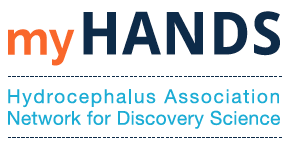Studies
The Hydrocephalus Association Network for Discovery Science (HANDS) Database
Search or Filter the studies below.
Are we missing an entry?
Submit an entry to this database.
Type of Study: Prevalence
Temporal trends of intraventricular hemorrhage of prematurity in Nova Scotia from 1993 to 2012
Year: 2015
Etiology: Post Hemorrhagic Hydrocephalus
Study Type: Prospective
Age: Neonate
# Screened: 87 patients
Population: Preterm neonates w/ Grade 4 IVH
Prevalence: Incidence: 37% developed post hemorrhagic hydrocephalus
Type of Study: Prevalence
Year: 2014
Etiology: Idiopathic Normal Pressure Hydrocephalus
Study Type: Prospective
Age: Adult
# Screened: 271 inhabitants of Takahata
Population: Adult
Prevalence: Incidence: 1.2/1000/year
Type of Study: Prevalence
Prevalence of idiopathic normal-pressure hydrocephalus.
Year: 2014
Etiology: Idiopathic Normal Pressure Hydrocephalus
Study Type: Prospective
Age: Adult
# Screened: 1,238 between 1986-2000
Population: Adult
Prevalence: Incidence: Age 70-79: 0.2% Age 80+: 5.9%
Type of Study: Prevalence
Year: 2013
Etiology: Post Infectious Hydrocephalus
Study Type: Prospective
Age: Adult
# Screened: 80 patients
Population: Tuberculous Meningitis
Prevalence: Incidence: 67% after tuberculous meningitis
Type of Study: Prevalence
Year: 2013
Etiology: Posttraumatic Hydrocephalus
Study Type: Prospective
Age: Adult
# Screened: 444 patients
Population: Traumatic Brain Injury
Prevalence: Incidence: 14.2% of severe TBI patients Prevalence in population 0.00252%
Type of Study: Prevalence
Year: 2013
Etiology: Posttraumatic Hydrocephalus
Study Type: Retrospective
Age: Adult
# Screened: 194 patients who had had a decompressive craniectomy for severe TBI between 2004 and 2010
Population: Traumatic Brain Injury
Prevalence: Incidence: 36% developed hydrocephalus requiring VP shunt
Type of Study: Prevalence
Epidemiology, natural history, progression, and postnatal outcome of severe fetal ventriculomegaly.
Year: 2013
Etiology: Ventriculomegaly
Study Type: Prospective
Age: Fetus
# Screened: 441,247 eligible births
Population: Fetus
Prevalence: Incidence: 3.6 severe/10,000 pregnancies, 64.3% of women terminated births
Type of Study: Prevalence
Year: 2011
Etiology: Post Hemorrhagic Hydrocephalus
Study Type: Retrospective
Age: Neonate
# Screened: 97 premature infants with IVH
Population: Intraventricular Hemorrhage
Prevalence: Incidence: 35% required VP shunt – all grade 3 or 4 IVH
Type of Study: Prevalence
Year: 2011
Etiology: Posttraumatic Hydrocephalus
Study Type: Retrospective
Age: Adult
# Screened: 389 patients w/ severe head trauma; 149 underwent decompressive craniectomy
Population: Traumatic Brain Injury
Prevalence: Incidence: 16.8% of those who underwent DC; 9.6% of the remaining patients who did not undergo DC
Type of Study: Prevalence
Prevalence, natural history, and clinical outcome of mild to moderate ventriculomegaly.
Year: 2011
Etiology: Ventriculomegaly
Study Type: Prospective
Age: Fetus
# Screened: 454,080 registered births
Population: Fetus
Prevalence: Incidence: 7.8 mild to moderate/10,000 total
Type of Study: Prevalence
Prevalence of congenital hydrocephalus in California, 1991-2000.
Year: 2011
Etiology: Congenital Hydrocephalus
Study Type: Retrospective
Age: Neonate
# Screened: 5,353,022 births
Population: Neonate
Prevalence: Incidence: 5.9/10,000
Type of Study: Prevalence
Twelve-year prevalence of common neonatal congenital malformations in Zhejiang Province, China.
Year: 2011
Etiology: Congenital Hydrocephalus
Study Type: Retrospective
Age: Neonate
# Screened: 83,888 perinatal, 1998-2009
Population: Neonate
Prevalence: Incidence: 0.92% of births
Type of Study: Prevalence
Incidence of intraventricular hemorrhage and post hemorrhagic hydrocephalus in preterm infants.
Year: 2010
Etiology: Post Hemorrhagic Hydrocephalus
Study Type: Prospective
Age: Neonate
# Screened: 57 neonates 35 with hemorrhage 7 with PHH
Population: Neonate
Prevalence: Incidence: 12.3% of premature neonates 20% of preterm with hemorrhage – directly related to severity
Type of Study: Prevalence
Year: 2010
Etiology: Congenital Hydrocephalus
Study Type: Retrospective
Age: Neonate
# Screened: 187,097 Registered neonates
Population: Neonate w/ Birth Defects
Prevalence: Incidence: 4.65/10,000 48% terminated pregnancies
Type of Study: Prevalence
Prevalence of possible idiopathic normal-pressure hydrocephalus in Japan: the Osaki-Tajiri project.
Year: 2009
Etiology: Idiopathic Normal Pressure Hydrocephalus
Study Type: Prospective
Age: Adult
# Screened: 567 participant randomly selected from population
Population: Adult
Prevalence: Incidence: 1.40% 140/10,000 aged 65+
Type of Study: Prevalence
Five-year incidence of surgery for idiopathic normal pressure hydrocephalus in Norway.
Year: 2009
Etiology: Idiopathic Normal Pressure Hydrocephalus
Study Type: Retrospective
Age: Adult
# Screened: 23.1M population 252 patients operated on
Population: Adult
Prevalence: Incidence: 1.09/100,000/year incidence In >65: 30.2/100,000/5 years
Type of Study: Prevalence
Reynaldo Martinez (electronic signature)
Year: 2008
Etiology: Idiopathic Normal Pressure Hydrocephalus
Study Type: Prospective
Age: Adult
# Screened: 220,000 inhabitants
Population: Adult
Prevalence: Incidence: 21.9/100,000 5.5/100,000/year
Type of Study: Prevalence
Year: 2008
Etiology: Idiopathic Normal Pressure Hydrocephalus
Study Type: Retrospective
Age: Adult
# Screened: 170 Randomly selected residents 65+
Population: Adult
Prevalence: Incidence: 2.90%
Type of Study: Prevalence
Risk factors related to hydrocephalus after traumatic subarachnoid hemorrhage.
Year: 2008
Etiology: Post Hemorrhagic Hydrocephalus
Study Type: Prospective
Age: All
# Screened: 301 consecutive patients
Population: Subarachnoid Hemorrhage
Prevalence: Incidence: 11.98% developed hydro
Type of Study: Prevalence
Hydrocephalus in children born in 1999-2002: epidemiology, outcome and ophthalmological findings.
Year: 2007
Etiology: Infantile hydrocephalus
Study Type: Prospective
Age: Neonate
# Screened: 82,106 live born children From 1999-2002
Population: Neonate
Prevalence: Incidence: 0.48/1,000

